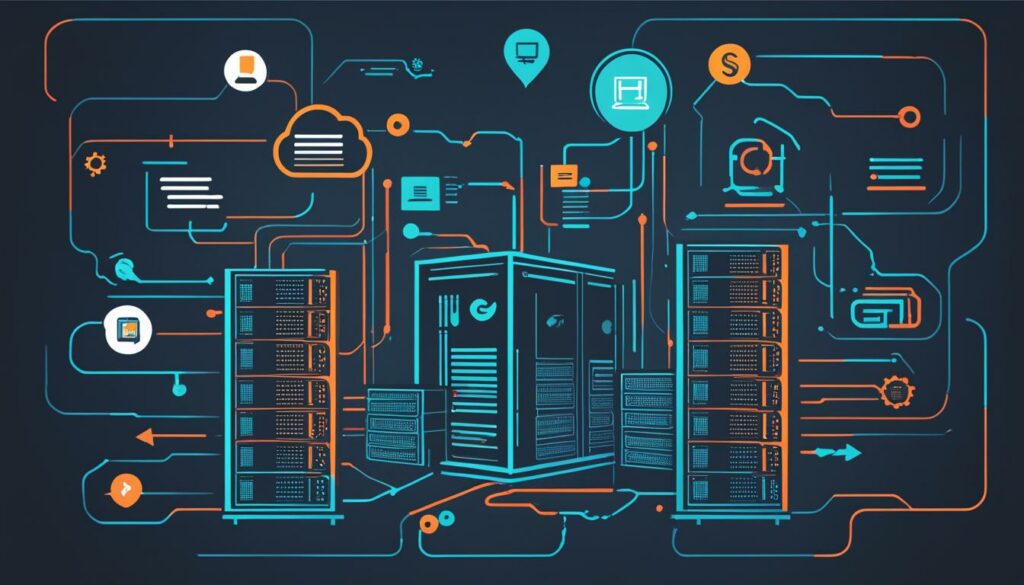Welcome to the world of Hosting and Internet of Things (IoT). In this article, we will explore key insights and best practices for integrating Hosting and IoT to enhance connectivity and security. Whether you are already familiar with website hosting and IoT platforms or just starting to dip your toes into the realm of IoT development, this article has something for you.
Cloud hosting has opened up a plethora of opportunities for businesses to leverage IoT technologies and achieve seamless connectivity. With the increasing number of IoT devices and the need for robust security measures, understanding IoT security becomes crucial for businesses of all sizes.
In this section, we will delve into the different aspects of Hosting and IoT, including web hosting, IoT connectivity, and managed hosting. We will also discuss the importance of IoT security and how it plays a vital role in protecting your data and maintaining the integrity of your IoT ecosystem.
Key Takeaways:
- Website hosting and IoT platforms provide the foundation for seamless IoT connectivity.
- Cloud hosting offers scalability and flexibility for IoT development.
- IoT security is crucial in protecting sensitive data and ensuring the overall integrity of your IoT ecosystem.
- Managed hosting services can help businesses effectively manage their IoT infrastructure and ensure optimum performance.
- Adopting best practices for IoT security is essential to safeguard against unauthorized access and data breaches.
Reducing Costs with IoT and Digital Twins After COVID-19 Lockdown
Companies that have experienced revenue loss due to the global COVID-19 lockdowns are seeking innovative ways to reduce costs. One promising solution lies in implementing IoT implementations involving digital twins. By leveraging digital twins, businesses can achieve cost savings and optimize their operations.
So, what exactly are digital twins? In simple terms, digital twins are virtual representations of physical objects or systems. They mimic the behavior, characteristics, and performance of their real-world counterparts. Through the integration of IoT sensors and data analytics, digital twins enable businesses to gain valuable insights and make data-driven decisions.
By adopting digital twin technology, companies can streamline their processes, enhance efficiency, and reduce expenses. For example, in manufacturing, digital twins can create virtual simulations that optimize production lines, minimizing material waste and downtime. In the healthcare sector, digital twin models can be utilized to monitor the performance of medical devices, optimizing maintenance schedules and reducing costs.
How IoT and Digital Twins Reduce Costs
The key to reducing costs lies in the ability to gather real-time data and analyze it effectively. By implementing IoT devices and sensors, businesses can collect accurate data about operational processes, performance metrics, and resource consumption. This data is then transmitted to the digital twin models for analysis and optimization.
One of the primary benefits of using IoT implementations and digital twins is predictive maintenance. By continuously monitoring the performance of physical assets, businesses can identify potential issues before they escalate into costly breakdowns. This proactive approach allows for timely maintenance interventions, thereby minimizing operational disruptions and reducing maintenance expenses.
“Predictive maintenance through digital twins has proven to be a game-changer for our manufacturing operations. By monitoring equipment in real-time and detecting anomalies early on, we’ve significantly reduced unplanned downtime and saved a substantial amount on maintenance costs.”
– John Matthews, Operations Manager at XYZ Manufacturing
In addition to predictive maintenance, digital twins enable businesses to optimize resource utilization and energy consumption. By analyzing data from IoT-connected devices, companies can identify areas of inefficiency and implement targeted optimization strategies. This includes optimizing production schedules, adjusting energy usage based on demand, and improving overall equipment effectiveness.
Real-World Examples
Let’s take a look at some real-world examples of how companies are leveraging IoT implementations and digital twins to reduce costs:
| Industry | Use Case | Cost Reduction |
|---|---|---|
| Manufacturing | Virtual simulations of production lines for optimization. | 30% decrease in material waste and 20% reduction in downtime. |
| Energy | Real-time monitoring and analysis of energy consumption. | 15% reduction in energy costs. |
| Transportation | Optimization of fleet management and route planning. | 25% decrease in fuel consumption and maintenance costs. |
These examples illustrate the potential for significant cost savings and operational improvements by leveraging IoT implementations and digital twins.
The Future of Cost Reduction through IoT and Digital Twins
As technology continues to advance, the possibilities for cost reduction through IoT and digital twins are expanding. Innovations such as artificial intelligence and machine learning are enhancing the capabilities of digital twins, enabling even more accurate simulations and predictive insights.
Companies that embrace IoT implementations and digital twins can gain a competitive advantage by optimizing their operations, reducing costs, and achieving sustainable growth. The key lies in identifying the areas where IoT and digital twins can deliver the most value, and developing strategic implementation plans.
“We see tremendous potential in the combination of IoT and digital twins for cost reduction and operational efficiency. The ability to create virtual replicas of our assets and optimize their performance in real-time has been a game-changer for our business.”
– Sarah Thompson, CEO of ABC Industries
By reducing costs through IoT and digital twins, businesses can not only recover from the impact of the COVID-19 lockdowns but also position themselves for long-term success in an increasingly competitive market.
IoT is Evolving from a Technology Initiative to Business Outcome
Organizations implementing IoT are shifting their focus from internal operational improvement to achieving business outcomes. This transition reflects the growing maturity of IoT initiatives and the recognition of its potential for driving revenue improvement and enhancing the customer experience. In order to successfully adopt IoT, collaboration between IT and business stakeholders is crucial.
Collaboration for Business Alignment
Collaboration between IT and business stakeholders is key to ensuring that IoT projects align with specific business objectives. By working together, these stakeholders can identify how IoT can contribute to revenue improvement and customer experience enhancement. This collaboration requires a deep understanding of the organization’s goals and a clear roadmap for achieving them.
“The key to successful IoT adoption is the collaboration between IT and business stakeholders, aligning IoT projects with specific business objectives to drive revenue improvement and enhance the customer experience.”
Moving Towards IoT Maturity
Companies with high levels of IoT maturity are more likely to achieve success in their IoT initiatives. IoT maturity refers to the organization’s ability to effectively implement and derive value from IoT technologies. It involves having well-defined strategies, robust technological infrastructure, and strong data governance practices.
As organizations progress in their IoT journey and mature their capabilities, they begin to realize the true potential of IoT for driving business outcomes. This shift from a technology initiative to a focus on business outcomes allows organizations to fully leverage the benefits of IoT and capitalize on new opportunities.
Achieving Business Outcomes
The ultimate goal of IoT initiatives is to achieve specific business outcomes that positively impact the organization’s bottom line. These outcomes vary depending on the industry and organization, but they often include revenue growth, cost reduction, operational efficiency, improved customer satisfaction, and innovation.
By aligning IoT projects with specific business objectives, organizations can track the impact of IoT on these outcomes and measure their return on investment. This allows for continuous improvement and optimization of IoT initiatives to drive even greater business value.
| Benefits | Description |
|---|---|
| Revenue Growth | IoT enables new revenue streams through innovative business models and improved product offerings. |
| Cost Reduction | IoT can optimize operations, reduce downtime, and improve resource allocation, leading to cost savings. |
| Operational Efficiency | By leveraging IoT data and analytics, organizations can streamline processes, automate tasks, and improve productivity. |
| Improved Customer Satisfaction | IoT enables personalized and seamless experiences, enhancing customer satisfaction and loyalty. |
| Innovation | IoT opens up opportunities for innovation, allowing organizations to stay competitive and differentiate themselves in the market. |

Defining Measurable IoT Goals and Strategies
Adopting IoT solutions and achieving business outcomes can be a complex journey. For organizations with limited experience in implementing IoT-based digital technologies, it is crucial to develop a well-defined IoT strategy with clear metrics to measure success. By following key steps and collaborating closely with business stakeholders, you can ensure that your IoT initiatives align with your enterprise objectives and drive tangible results.
Understanding Your Enterprise Objectives
Before diving into IoT implementation, it’s essential to have a comprehensive understanding of your enterprise objectives. Identify the specific business outcomes you aim to achieve through IoT solutions. Whether you’re seeking operational efficiency, cost savings, improved customer experience, or revenue growth, clarifying your goals will help shape your IoT strategy.
Aligning Outcomes with Strategy
Once you have a clear understanding of your enterprise objectives, it’s time to align your desired outcomes with your IoT strategy. Consider how IoT solutions can directly contribute to achieving your goals. Define measurable metrics that will allow you to track progress and evaluate the success of your IoT initiatives. These metrics could include Key Performance Indicators (KPIs) such as cost reduction percentages, increased operational efficiency, or customer satisfaction ratings.
Closely Collaborating with Business Stakeholders
Successful IoT implementation requires collaboration and alignment between IT and business stakeholders. Engage in open communication and involve key decision-makers from various departments to ensure that your IoT strategy supports the overall business objectives. By working together, you can leverage the expertise and insights of different teams to create a robust and effective IoT implementation plan.
Remember, measuring the impact and success of your IoT initiatives is crucial. Continuously monitor and evaluate your metrics to make data-driven decisions and refine your strategy for optimal results. With a well-defined IoT strategy and measurable goals in place, you can empower your organization to harness the full potential of IoT and drive meaningful business outcomes.

Key Steps for Defining Measurable IoT Goals and Strategies
| Step | Description |
|---|---|
| 1 | Understand your enterprise objectives and desired business outcomes. |
| 2 | Align your IoT strategy with the identified goals. |
| 3 | Define measurable metrics to track progress and evaluate success. |
| 4 | Collaborate closely with business stakeholders for alignment and support. |
| 5 | Continuously monitor metrics and refine your IoT strategy as needed. |
Gartner IoT Insights for Strategy Success
The Internet of Things (IoT) is revolutionizing business operations, and staying abreast of the latest IoT trends is essential for organizations seeking digital transformation. To navigate this rapidly evolving landscape successfully, strategy leaders can rely on the valuable research and insights provided by Gartner, a renowned global research and advisory firm.
Gartner’s expertise in IoT enables organizations to make well-informed decisions and develop effective action plans. By leveraging Gartner’s research, businesses can stay ahead of emerging trends and harness the power of IoT to drive innovation and achieve strategic objectives.
Gartner’s research covers a wide range of IoT topics, including:
- IoT adoption and implementation strategies
- Emerging trends and technologies
- Best practices for IoT security
- Impact of IoT on digital transformation
- IoT analytics and data management
With access to Gartner’s insights, organizations can develop robust IoT strategies tailored to their unique business needs. Gartner’s recommendations help businesses identify the most relevant and impactful IoT solutions, optimize their IoT investments, and drive tangible business outcomes.
Benefits of Leveraging Gartner’s Expertise:
- Stay informed about the latest IoT trends and innovations
- Gain insights into successful IoT implementation strategies
- Align IoT initiatives with broader digital transformation efforts
- Develop robust action plans based on industry best practices
- Maximize the return on investment in IoT technologies
“Gartner’s research provides invaluable guidance for organizations looking to harness the transformative power of IoT. By leveraging their insights, businesses can develop effective strategies, mitigate risks, and drive measurable outcomes in the age of digital transformation.”
Through Gartner’s trusted research, organizations can navigate the complexities of IoT and unlock the full potential of digital transformation. By incorporating Gartner’s insights into their IoT strategies, businesses can position themselves at the forefront of technological innovation and gain a competitive edge in the market.
| Gartner IoT Insights | Benefits |
|---|---|
| Identification of emerging trends and technologies | Stay ahead of the competition and drive innovation |
| Guidance on IoT strategy development and implementation | Develop robust action plans and achieve business outcomes |
| Best practices for IoT security and risk mitigation | Safeguard sensitive data and protect against cyber threats |
| Insights into the impact of IoT on digital transformation | Align IoT initiatives with broader business objectives |
| Recommendations for optimizing IoT investments | Maximize ROI and drive cost-effective IoT implementations |

Best Practices for IoT Security
When it comes to the Internet of Things (IoT), security is a top priority. Protecting sensitive data and ensuring the integrity of IoT devices are essential in today’s interconnected world. By implementing best practices for IoT security, you can safeguard against unauthorized access, data breaches, and cyber threats.
Hardware Tamper Resistance
One important aspect of IoT security is ensuring hardware tamper resistance. This involves designing devices with physical barriers that make it difficult for unauthorized individuals to access or manipulate the hardware. Implementing features such as secure enclosures, tamper-evident seals, and strong authentication mechanisms can help prevent tampering and protect IoT devices from compromise.
Network Security
Securing your IoT network is crucial to prevent unauthorized access and protect the transmission of data. Best practices for network security include implementing strong encryption protocols, using secure communication channels, and regularly updating and patching network devices. It’s also important to segment your network to limit access to sensitive data and resources, reducing the potential impact of a security breach.
Overall System Security
Ensuring the overall security of your IoT system involves a holistic approach that encompasses various aspects. This includes regularly updating firmware and software to address vulnerabilities, implementing strong access controls and authentication mechanisms, and conducting regular security audits and risk assessments. It’s also important to educate users and stakeholders about IoT security best practices to promote a security-conscious culture.
“Implementing best practices for IoT security can significantly reduce the risk of a successful cyber attack and protect your sensitive data and devices.”
By following these best practices and adopting a proactive approach to IoT security, you can enhance the protection of your IoT ecosystem and mitigate potential risks. Remember that IoT security is an ongoing process, and it’s important to stay updated with the latest security trends and standards to effectively address emerging threats.
| Best Practices | Benefits |
|---|---|
| Making hardware tamper-resistant | Protects against physical attacks and unauthorized access |
| Securing networks with strong encryption | Prevents unauthorized access and data interception |
| Regularly updating firmware and software | Addresses security vulnerabilities and protects against exploits |
| Implementing strong authentication mechanisms | Ensures only authorized users can access IoT devices and systems |
| Conducting regular security audits and risk assessments | Identifies vulnerabilities and potential areas of improvement |
Implementing these best practices for IoT security will help you establish a robust and resilient IoT ecosystem. By prioritizing security at every level, you can safeguard your devices, data, and ensure the confidentiality, integrity, and availability of your IoT infrastructure.
Good Practices for Security of IoT in Smart Manufacturing
In the rapidly evolving landscape of smart manufacturing and Industry 4.0, ensuring robust security measures for IoT is of paramount importance. By implementing good practices, companies can safeguard their connected devices, sensitive data, and critical infrastructure against potential security threats. Here are some key practices to consider:
1. Develop Security Policies
Establishing comprehensive security policies is essential for mitigating risks in the IoT ecosystem. These policies should outline guidelines for device authentication, data encryption, access control, and incident response. By clearly defining security protocols, organizations can ensure uniform adherence to security measures across the manufacturing environment.
2. Implement Security Measures in the Design Phase
Integrating security measures right from the design phase of IoT devices and systems is crucial. This approach enables the identification and elimination of vulnerabilities early on, reducing the likelihood of security breaches later in the production process. Designing devices with features like tamper-resistant hardware and secure firmware updates can significantly enhance the security posture of smart manufacturing systems.
3. Manage Vulnerabilities
Regular vulnerability assessments and patch management play a vital role in maintaining a secure IoT infrastructure. By proactively identifying and addressing vulnerabilities, organizations can stay ahead of potential threats. Timely software updates and patch deployments help ensure that known security weaknesses are promptly mitigated, reducing the risk of exploitation.
4. Ensure Data Protection
Protecting sensitive data generated and transmitted by IoT devices is imperative in smart manufacturing environments. Employing encryption techniques, secure transmission protocols, and access controls can safeguard data from unauthorized access or tampering. Data protection measures should also include securing data storage infrastructure and implementing robust backup and recovery mechanisms.
5. Threat Analysis and Risk Assessment
Performing regular threat analysis and risk assessments is crucial for smart manufacturing organizations. By identifying potential security threats specific to IoT deployments, companies can prioritize resources and implement targeted security controls. This proactive approach allows for the development of effective risk mitigation strategies and the allocation of resources where they are needed most.
“Implementing good practices for IoT security is essential in smart manufacturing environments. By developing security policies, incorporating security measures in the design phase, managing vulnerabilities, and ensuring data protection, companies can mitigate potential risks effectively.”
To illustrate the importance of IoT security in smart manufacturing, consider the following table:
| Security Measure | Benefits |
|---|---|
| Comprehensive Security Policies | Uniform adherence to security measures, clear guidelines for device authentication and incident response. |
| Implementation of Security Measures in Design Phase | Early vulnerability identification, better protection against security breaches. |
| Effective Vulnerability Management | Timely patch deployments, reduced risk of exploitation. |
| Data Protection | Safeguarding sensitive data from unauthorized access or tampering. |
| Threat Analysis and Risk Assessment | Proactive identification of security threats, targeted security controls. |
By implementing these good practices, smart manufacturing organizations can enhance the security posture of their IoT deployments, mitigate potential risks, and safeguard the integrity and confidentiality of sensitive data.
Conclusion
In conclusion, integrating hosting and the Internet of Things (IoT) can provide businesses with numerous opportunities to enhance connectivity, achieve desired business outcomes, and improve overall efficiency. By implementing best practices for IoT security and following recommended strategies, you can effectively navigate the evolving landscape of IoT, ensuring the safety of your connected devices and leveraging IoT’s potential for innovation and growth.
When it comes to IoT security, it is crucial to adopt the right measures to safeguard your sensitive data and prevent unauthorized access. Implementing best practices such as hardware tamper resistance, securing networks, and ensuring overall system security can significantly strengthen your IoT ecosystem’s defense against potential cyber threats and data breaches.
Furthermore, successful integration of hosting and IoT requires a seamless connectivity and integration framework. By adopting proven methods and standards for connectivity and integration, you can ensure the smooth interaction between your IoT devices, platforms, and other business systems. This will enable you to gather valuable insights, optimize operations, and drive better business outcomes.
In summary, by prioritizing IoT security best practices, focusing on connectivity and integration, and aligning your IoT initiatives with specific business objectives, you can unlock the true potential of IoT for your organization. Embracing the interconnected nature of IoT and implementing robust security measures will empower you to drive innovation, improve efficiency, and achieve the desired business outcomes in an increasingly connected world.
FAQ
Q: How can IoT and digital twins help businesses reduce costs after the COVID-19 lockdown?
A: IoT implementations involving digital twins have shown promise in achieving cost savings for companies that have experienced revenue loss due to the global COVID-19 lockdowns. Examples and industry case studies demonstrate how IoT and digital twins can be utilized to lower expenses for businesses.
Q: What is the shift in focus for organizations implementing IoT?
A: Organizations implementing IoT are shifting their focus from internal operational improvement to achieving specific business outcomes. Successful IoT adoption requires collaboration between IT and business stakeholders to align IoT projects with business objectives for revenue improvement and enhanced customer experience.
Q: How can organizations with little experience in adopting IoT-based digital technologies ensure successful outcomes?
A: Organizations with little experience in adopting IoT-based digital technologies must develop a well-defined IoT strategy with clear metrics to measure success. Key steps include understanding the enterprise’s business objectives, aligning outcomes with strategy, and closely collaborating with business stakeholders.
Q: How can Gartner’s research and insights help organizations with their IoT strategies?
A: Gartner provides valuable research and insights on IoT, helping strategy leaders stay informed about emerging trends and navigate digital transformations successfully. By leveraging Gartner’s expertise, organizations can create and implement stronger action plans and make well-informed decisions for their IoT strategies.
Q: What are the best practices for ensuring IoT security?
A: Implementing best practices for IoT security involves various measures, such as making hardware tamper-resistant, securing networks, and ensuring overall system security. These practices help safeguard against unauthorized access, data breaches, and cyber threats.
Q: What are the good practices for IoT security in smart manufacturing?
A: In the context of smart manufacturing and Industry 4.0, implementing good practices for IoT security includes developing security policies, implementing security measures in the design phase, managing vulnerabilities, and ensuring data protection. Threat analysis and risk assessment play a significant role in identifying potential security threats and mitigating them effectively.
Q: How can integrating hosting and the Internet of Things (IoT) enhance connectivity and improve business outcomes?
A: Integrating hosting and the Internet of Things (IoT) offers numerous opportunities for businesses to enhance connectivity, achieve business outcomes, and improve overall efficiency. By implementing best practices for IoT security and following recommended strategies, organizations can navigate the evolving landscape of IoT and leverage its potential for innovation and growth.












